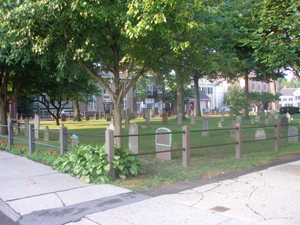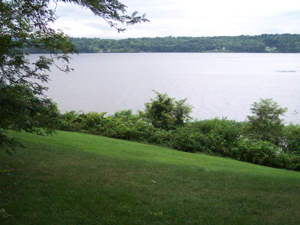Driving north from Cherry Hill, New Jersey to Port Jervis, New York, we seemed to go from one
town to another, without interruption,
 The Senate House, Kingston
except perhaps at the very end. Starting near High
Point, New Jersey, and continuing north from Port Jervis on Highway 209, we began to encounter
actual countryside -- farms and fields and forests without any suburban housing developments.
The Senate House, Kingston
except perhaps at the very end. Starting near High
Point, New Jersey, and continuing north from Port Jervis on Highway 209, we began to encounter
actual countryside -- farms and fields and forests without any suburban housing developments.
It continued that way into New York State, where we drove up the Neversink River valley to the
country towns of Ellenville and Accord, where family members had once lived. We continued through
the Hidden Valley to Kingston, the first state capital of New York.
Kingston was settled in the mid-1600s as two small separate villages: a commercial area right
on the river in a spot where boats could be loaded with crops and freight from areas higher along
the Palisades, and
 17th century Kingston cemetery
an agricultural village where the settlers -- Dutch, French, and English --
fortified their homes against Indian raids and planted corn.
17th century Kingston cemetery
an agricultural village where the settlers -- Dutch, French, and English --
fortified their homes against Indian raids and planted corn.
It was on the hill that the capitol was located. We walked through the Historic District
early in the morning, in air already muggy, past the cemetery filled with Dutch settlers
and past many 18th century buildings. The Senate House, originally built as the home of
Colonel Wessel Ten Broeck in 1676, was the location of the first government of the State
of New York after our Constitution was adopted in 1777.
Crossing the Hudson and continuing north, we visited the 18th century Livingston family manor,
Clermont. Robert Livingston was one of the drafters of the Declaration of Independence, and
administered the oath of office to President Washington. He was a partner with Robert Fulton
 Clermont, the Livingston home
in developing steamboats, and also negotiated the Louisana Purchase for President Jefferson.
Clermont, the Livingston home
in developing steamboats, and also negotiated the Louisana Purchase for President Jefferson.
Although the present Clermont estate comprises but
500 acres along the Hudson River, the
Livingston family had extensive landholdings, which were increased by marriage with the Beekman
family. In truth, Clermont was a manor house in the European sense, and represented
enormous wealth and power throughout the nineteenth and early twentieth centuries. Many of the Livingston
properties were worked by tenant farmers.
The story of the decline of the Livingston family was not part of the park literature,
 Part of the Clermont groundsbut it
came to pass that the estate was deeded to the State of New York in 1962, and it remains as a
reminder of an opulence dating back to colonial times. The lawns and gardens, and the views of the
placid river, were a great pleasure to us, and we felt that we could have been in the English or
French countryside. Later on in the day, the property would be hosting a children's summer history
camp and croquet tournament; by arriving early we had avoided the crowds.
Part of the Clermont groundsbut it
came to pass that the estate was deeded to the State of New York in 1962, and it remains as a
reminder of an opulence dating back to colonial times. The lawns and gardens, and the views of the
placid river, were a great pleasure to us, and we felt that we could have been in the English or
French countryside. Later on in the day, the property would be hosting a children's summer history
camp and croquet tournament; by arriving early we had avoided the crowds.
We were in the so-called Great Estate Region of the Hudson Valley, and found another estate,
Olana, on top of a high hill overlooking the river. The owner, Frederic Church, was a member
of
 Church's home at Olana
the Hudson River School of nineteenth century landscape artists, and also a landscape architect,
who was inordinately proud of his property. The house itself exhibits a wide variety of
flashy brickwork and ornate curlicues with an oriental flavor. Many acres of hillside were carefully cleared and
planted by Church to enhance the setting. Today's flower garden is indeed lavish, a special attraction
for visitors.
Church's home at Olana
the Hudson River School of nineteenth century landscape artists, and also a landscape architect,
who was inordinately proud of his property. The house itself exhibits a wide variety of
flashy brickwork and ornate curlicues with an oriental flavor. Many acres of hillside were carefully cleared and
planted by Church to enhance the setting. Today's flower garden is indeed lavish, a special attraction
for visitors.
We pursued, unsuccessfully, the birth certificate of Bob's aunt Glay, who was born near
grandfather's
travelling sawmill located in East Chatham, New York in 1897 and played in the heaps of sawdust.
East Chatham,
 The Hudson from Clermont
it turns out, is not a town but a hamlet, so its official records were divided between
the towns of Chatham and Canaan. Alas! Neither of the two friendly town clerks could find the birth
record, but we have written to the town historian to see if there are any records of the lumber camp.
The Hudson from Clermont
it turns out, is not a town but a hamlet, so its official records were divided between
the towns of Chatham and Canaan. Alas! Neither of the two friendly town clerks could find the birth
record, but we have written to the town historian to see if there are any records of the lumber camp.
Upstate New York presented a relaxing contrast to our last four
weeks in suburban New Jersey. We were,
as always, curious to learn a little more history while exploring beautiful countryside. And we wonder
what the future holds in store for New York State, which has been steadily losing population. We found
ourselves hoping that the marvellous prosperity represented by the great estates could somehow spread to
all the population of the Hudson valley.
 The Senate House, Kingston
except perhaps at the very end. Starting near High
Point, New Jersey, and continuing north from Port Jervis on Highway 209, we began to encounter
actual countryside -- farms and fields and forests without any suburban housing developments.
The Senate House, Kingston
except perhaps at the very end. Starting near High
Point, New Jersey, and continuing north from Port Jervis on Highway 209, we began to encounter
actual countryside -- farms and fields and forests without any suburban housing developments.
 17th century Kingston cemetery
17th century Kingston cemetery Clermont, the Livingston home
Clermont, the Livingston home Part of the Clermont grounds
Part of the Clermont grounds Church's home at Olana
Church's home at Olana The Hudson from Clermont
The Hudson from Clermont